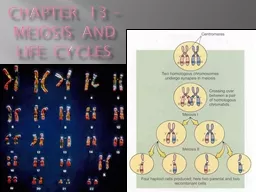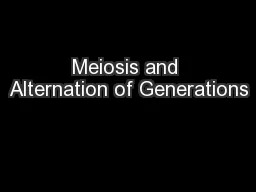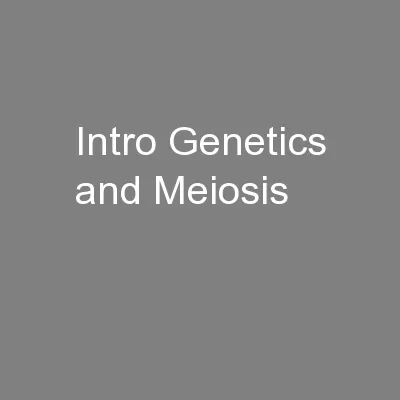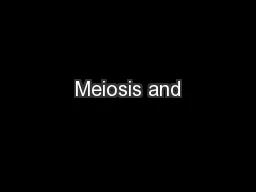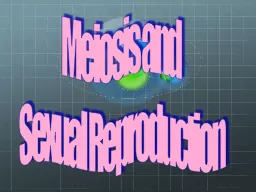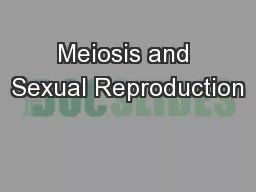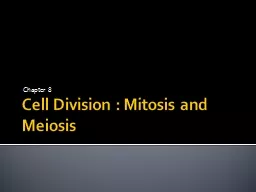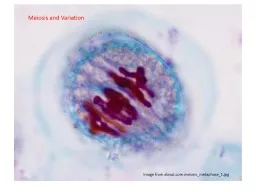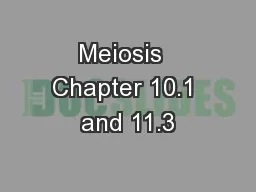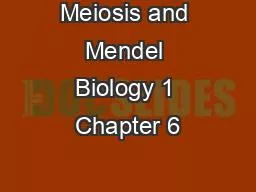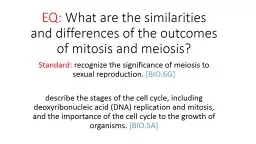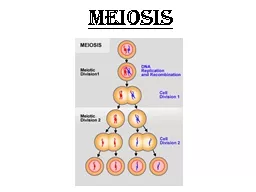PPT-Chapter 13 – Meiosis and life cycles
Author : phoebe-click | Published Date : 2018-10-06
1 Introductory Vocabulary 2 Heredity t he transmission of traits from one generation to the next Variation when o ffspring differ somewhat from their parents
Presentation Embed Code
Download Presentation
Download Presentation The PPT/PDF document "Chapter 13 – Meiosis and life cycles" is the property of its rightful owner. Permission is granted to download and print the materials on this website for personal, non-commercial use only, and to display it on your personal computer provided you do not modify the materials and that you retain all copyright notices contained in the materials. By downloading content from our website, you accept the terms of this agreement.
Chapter 13 – Meiosis and life cycles: Transcript
1 Introductory Vocabulary 2 Heredity t he transmission of traits from one generation to the next Variation when o ffspring differ somewhat from their parents and siblings. And 57375en 57375ere Were None meets the standard for Range of Reading and Level of Text Complexity for grade 8 Its structure pacing and universal appeal make it an appropriate reading choice for reluctant readers 57375e book also o57373ers students Chapter 12. Outline. Introduction. Asexual. Sexual Reproduction. The Phases of Meiosis. Division I. Division II. Alternation . of Generations. Introduction. Asexual . Reproduction . - . p. roduction . Chapter 13. Vocabulary. heredity. variation. gene. gamete. somatic cell. asexual . vs. sexual reproduction. autosomes. sex chromosomes. allele. dominant . vs. recessive. diploid . vs. haploid. parental generation. Sexual Life Cycles. Which of the following transmits genes from both parents to child, or from one generation of a family to another?. DNA. gametes. somatic cells. mitosis. nucleotides. Which of the following transmits genes from both parents to child, or from one generation of a family to another?. Sexual Reproduction. SEXUAL REPRODUCTION. Sex cells formed by meiosis. Requires 2 parents. Offspring not identical. The process that results in the formation of . gametes. Sex cells, egg or sperm, which have . Chapter 10. Overview of Meiosis. 10.1. Overview of Meiosis. Meiosis. - type of nuclear division that reduces the chromosome number from the diploid number to the haploid number.. Gametes. - reproductive cells. Chapter 8. Asexual vs. Sexual reproduction. Asexual reproduction – new organisms/cells are genetically identical to parent cells/organisms . Sexual reproduction – offspring have a combination of genes from both parents. . Image from about.com . meiosis_metaphase_1.jpg. . Mutations. (changes in an organism’s DNA) are the . original. . source of . all. genetic variation. Mutations create different versions of genes called . Before we start genetics, let's review the process of what makes us all look different compared to our siblings, family, and classmates!. Sexual Reproduction. Sexual reproduction creates genetic variability. That is why we all look different and you look different from your siblings! . 6.1 Chromosomes and Meiosis. Cells can be divided into 2 major groups:. Somatic (body): most of body tissue and organs. Germ: found in reproductive organs, develop into gametes. Gametes are sex cells – ova (eggs) & spermatozoa (sperm). Standard: . recognize the significance of meiosis to sexual reproduction. . . [. BIO.6G. ]. describe the stages of the cell cycle, including deoxyribonucleic acid (DNA) replication and mitosis, and the importance of the cell cycle to the growth of organisms. Meiosis is the. . type of . cell division by which . germ cells . (eggs and sperm) . are produced. . One parent cell produces . four . daughter cells. . Daughter cells have half the number of chromosomes found in the parent cell. . Human. Cat. Shrimp. Bean. Before Meiosis. Chromosome. number (haploid or diploid?. 46. ?. ?. ?. Number of pairs of homologous. chromosomes. 23. ?. 127. ?. After Meiosis I. Chromosome number (haploid or diploid?). 1 identify the stages of meiosis. Only diploid cells caages of meiosis in a diploid cell where 2N = 6Meiosis involves 2 consecutive cell divisions. Since the DNA is duplicated result is 4 haploid cel
Download Document
Here is the link to download the presentation.
"Chapter 13 – Meiosis and life cycles"The content belongs to its owner. You may download and print it for personal use, without modification, and keep all copyright notices. By downloading, you agree to these terms.
Related Documents

